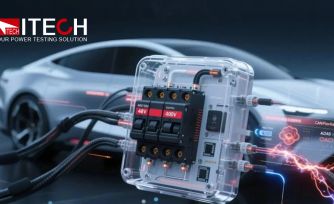Test a starter motor using a low voltage high current power supply
What is a starter motor ? A starter (also self-starter, cranking motor, or starter motor) is a device used to rotate (crank) an internal-combustion engine so as to initiate the engine's operation under its own power. Starters can be electric, pneumatic, or hydraulic. The starter motor can effectively reduce manpower requirements, and is more rapid and reusable. It is often used in the start of automobile engines and the start of large construction machinery.
How does a starter motor work ?
The electric starter motor or cranking motor is the most common type used on gasoline engines and small diesel engines. The modern starter motor is either a permanent-magnet or a series-parallel wound direct current electric motor with a starter solenoid (similar to a relay) mounted on it. When DC power from the starting battery is applied to the solenoid, usually through a key-operated switch (the "ignition switch"), the solenoid engages a lever that pushes out the drive pinion on the starter driveshaft and meshes the pinion with the starter ring gear on the flywheel of the engine.
Case study : use ITECH battery simulator to test the starter motor
1. Test requirement
According to the parameter of the starter motor below, the battery simulator should be :
Ø voltage range: 8-28V, adjustable
Ø max. current output is up to 2000A with the min. voltage
Ø internal resistance adjustable ranging 5-10mΩ to simulate lead-acid battery
Ø power regenerative and bidirectional to save energy

2. Test Challenge
—— Most of the battery simulators (bidirectional power supply) on the market, the voltage normally ranges from 80V to 100V, and the current of a 6kW unit only ranges from 120A to 180A. If you want to achieve the current output up to 2000A, the output power and the size of the instrument will be very big. Therefore, they can not meet the test requirements.
3. ITECH innovative solutions
IT-M3900C Bidirectional DC Power Supply
——It has advantages of small size while low-voltage and high-current output at the same time
a) Voltage output: 0-32V, cover the motor parameter
b) High output power under rated voltage: multiple choices from 1U model 32V/80A/2kW to 2U model 32V/480A/12 kW。Parallel connection is available, not calibration needed after connection
c) Faster, voltage rise and fall within 15ms, current rise and fall within 5ms and the dynamic response is up to 1ms
d) Bidirectional, it can automatically absorb the feedback energy generated from the load and convert it into alternating current and feed back to the grid.
e) High power density in tiny body, easy to be rack mounted
f) IR adjustable, high resolution up to 1mΩ






